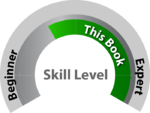About This Title
Pages: 580
Published: August 2020
ISBN: 9781680507201
In Print

Quantum Computing
Program Next-Gen Computers for Hard, Real-World Applications
by Nihal Mehta, Ph.D.
You’ve heard that quantum computing is going to change the world. Now you can check it out for yourself. Learn how quantum computing works, and write programs that run on the IBM Q quantum computer, one of the world’s first functioning quantum computers. Develop your intuition to apply quantum concepts for challenging computational tasks. Write programs to trigger quantum effects and speed up finding the right solution for your problem. Get your hands on the future of computing today.
eBook Formats:
PDF for desktop/tablets
epub for Apple Books, e-readers
mobi for Kindle readers
Get all eBook formats here for $29.95 (USD)
Paperback Formats:
Order via Bookshop (U.S. Only)
Please support indie bookstores!
Find indie bookstores in the U.S. Find indie bookstores around the world.
Quantum computing overhauls computer science. Designing life-saving drugs and solving super-large logistics problems that are difficult or impossible for classical computers to handle are now within reach. Instead of iterating through each possible configuration one by one, quantum computing speeds up the search by giving you the tools to examine all possibilities simultaneously to find those that work. Now you can work with real quantum computers instead of just talking about them theoretically.
Discover a new visual way of looking at quantum bits that makes quantum computing intuitive for computer programmers. Master the special properties that make them different, and more powerful, than classical bits. Control quantum bits with gates and create circuits to model complex problems. Write programs that run on real quantum machines to solve problems that classical computers struggle with. Dive into quantum optimization and cryptography.
Get a head start on the technology that will drive computer science into the future.
What You Need
Access to the IBM quantum computer, via any internet connectionResources
Releases:
Contents & Extracts
- Preface

- Is This Book for Me?
- How Will This Book Give Me What I Want?
- What’s Unique in This Book?
- Online Resources
- Acknowledgments
- Hello Quantum
- Types of Quantum Computers
- Quantum Computing in Thirty Seconds
- Your First Quantum
Program

- Bottom Line
- Goodbye Mr. Bits—From Classical to Quantum Bits
- Comparing Classical to Quantum Computing
Modeling Quantum Bits with the Qubelets Model
- Measuring Qubits
- Bottom Line
- Try Your Hand
- Comparing Classical to Quantum Computing
- Elementary, My Dear Watson—Quantum Logic
- NOT (X) Gate
- Controlled NOT (CNOT) Gate
- Controlled Controlled NOT (CCNOT) Gate
- Logic Expressions to Quantum Circuit
- Bottom Line
- Try Your Hand
- All Together Now—Quantum Superposition
- Operating on Qubelets
Putting Qubits in “Blended” States
- Multi-Qubit Superposition: The Mega-Qubit
- Triggering Superposition in Practical Quantum Circuits
- Bottom Line
- Try Your Hand
- Operating on Qubelets
- Beam Me Up, Scotty—Quantum Tagging and Entangling
- Tagging the Optimal Solution
- Entangling Qubits
- Entanglement in Quantum Computing
- Bottom Line
- Try Your
Hand

- Designer Genes—Custom Quantum States
- Quantum States and Probabilities
- Rotating Qubelets Through Any Angle
- Universal Quantum Gates
- Bottom Line
- Small Step for Man—Single Qubit Programs
- Quantum States as Vectors
- Quantum Gates as Matrices
- Intuitively Analyzing the Quantum Gate Matrix
- Classifying Quantum Gates
- Sequence of Gates as Matrix Multiplication
- Bottom Line
- Giant Leap for Mankind—Multi-Qubit Programs
- Idealized States Redux—Multi-Qubit Version
- Speed Reading a Gate’s Operation from Its Matrix
- Two-Qubit Gate Matrices
- Working with Blended States: Mega-Qubit as a Tensor
- Design a Teleporting Circuit
- Bottom Line
- Try Your Hand
- Alice in Quantumland—Quantum Cryptography
- Encrypting with Symmetric Keys
- Tell-Your-Boss Version: The “Key” Idea
- The BB84 Key Exchange Mechanism
- How Real Is BB84?
- Bottom Line
- Try Your Hand
- Quantum Search
- Grover’s Algorithm
- Fundamental Circuit Pattern for Searching
- Searching for an Optimal Schedule
- Bottom Line
- Try Your Hand
- Where to Go from Here
- Well-Known Algorithms
- Programming with Qiskit
- Amazon, Google, and Microsoft’s Quantum Computers
- Bottom Line
- Try Your Hand
- Mathematical Review
- Classical Logic Gates and Circuits
- Boolean Logic Expressions
- Working with Matrices and Vectors
- From Qubelets to the Bloch Sphere
- Visualizing the Qubit in 3D Space
- Writing the Quantum State Using Polar Coordinates
- Quantum State in a Transformed Space
- Quantum Mechanics with Qubelets
- Mach-Zehnder Interferometer
- Solutions to Exercises
- Quantum Bits Solutions
- Quantum Logic Gates Solutions
- Quantum Superposition Solutions
- Quantum Tagging and Entangling Solutions
- Custom Quantum States Solutions
- Single Qubit Programs Solutions
- Multi-Qubit Programs Solutions
- Quantum Cryptography Solutions
- Quantum Search Solutions
- Where to Go from Here Solutions
Author
Nihal Mehta has a Ph.D. from the University of Pennsylvania and has published articles in peer-reviewed journals in artificial intelligence, mathematical optimization and physics. He has championed the use of advanced optimization techniques and machine learning in decision support systems for global companies. He has seen first hand the shortcomings of current technology and fervently believes in quantum computing’s potential to define the future of computing. His first program was to play tic-tac-toe on a scientific calculator.eBook Formats:
PDF for desktop/tablets
epub for Apple Books, e-readers
mobi for Kindle readers
Get all eBook formats here for $29.95 (USD)
Paperback Formats:
Order via Bookshop (U.S. Only)
Please support indie bookstores!
Find indie bookstores in the U.S. Find indie bookstores around the world.
Related Titles:

About This Title
Pages: 580
Published: August 2020
ISBN: 9781680507201
Edition: 1
In Print


